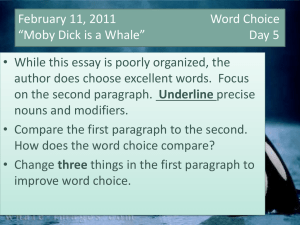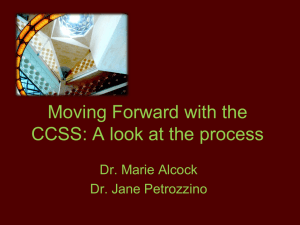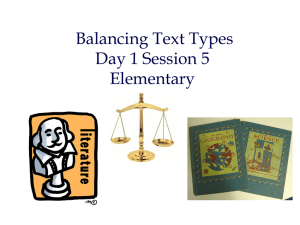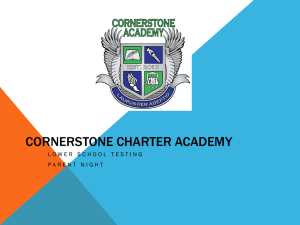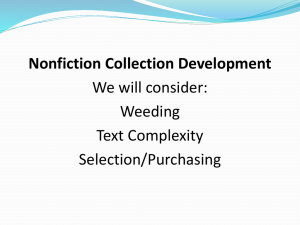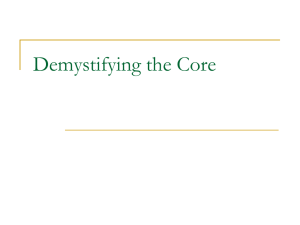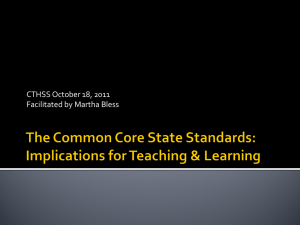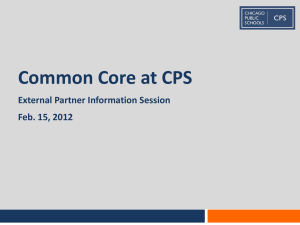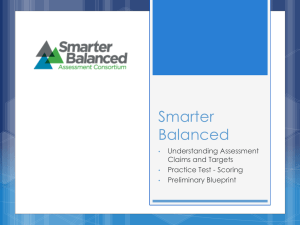Common Core & Public Libraries
advertisement
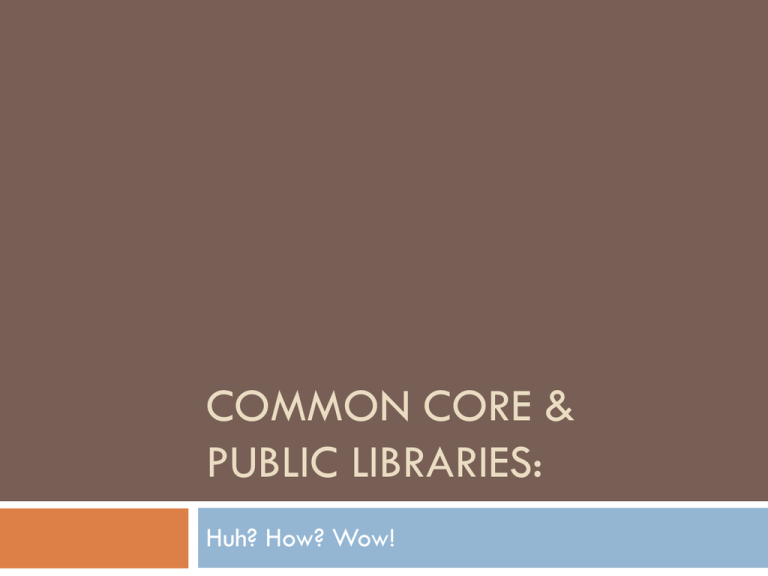
COMMON CORE & PUBLIC LIBRARIES: Huh? How? Wow! Huh? What are the Common Core State Standards? Common Core State Standards are …shared content standards for English language arts, literacy in the content areas, & math …designed to help ensure that all students are college and career ready in literacy and mathematics no later than the end of high school …meant to describe what students in our nation should know and be able to do …adopted by 45 states …often referred to as Common Core, CC, or CCSS http://www.ode.state.or.us/wma/teachlearn/commoncore/common-core-fact-sheet.pdf Put another way, CCSS …represent a coherent progression of learning expectations in English language arts and math …are designed to prepare K12 students for college and career success …define knowledge & skills students should have …describe end-of-year expectations …provide consistency in expectations among states …emphasize rigor and critical thinking http://educationnorthwest.org/webfm_send/1158 (very helpful organizational overview) http://www.ccsso.org/Resources/Digital_Resources/Common_Core_Implementation_Video_Series.html http://www.corestandards.org/ELA-Literacy/introduction/key-design-consideration Common Core State Standards are … not fully implemented in Oregon yet Adopted in Oregon in October 2010 Instruction must align by end of 2012/13 school year Statewide assessments will reflect CCSS as of 2014/15 … not meant to determine how learning goals should be achieved Districts and educators retain flexibility around lesson plans, process, activities, end products, etc. http://www.ode.state.or.us/wma/teachlearn/commoncore/oregon-initiatives-timeline.pdf ODE Common Core Homepage http://www.ode.state.or.us/search/page/?id=2860 Start here Resources for various audiences Toolkits ODE Resources for CCSS in Math http://www.ode.state.or.us/teachlearn/real/newspaper/Newspaper_Section.aspx?subjectcd=MA http://www.ode.state.or.us/search/page/?id=3403 Standards by grade level for K-8 Standards by discipline for 9-12 Additional resources We will not address math today. ODE Resources for CCSS in ELA Standards for English language arts (ELA) & literacy in history/social studies, science, and technical subjects http://www.ode.state.or.us/search/page/?id=3359 http://www.ode.state.or.us/teachlearn/real/newspaper/newspaper_section.aspx?subjectcd=ELA Standards by grade level or grade groupings Info on text complexity & text exemplars Additional resources Note: literacy in content areas standards supplement existing standards for history/ social studies, science, and technology ODE Tools to Manipulate Standards Standards by Design http://www.ode.state.or.us/teachlearn/real/standards/ Select one or multiple subjects Can choose to include support materials Generate an Excel spreadsheet or printable PDF Searchable Standards Search http://www.ode.state.or.us/teachlearn/real/standards/searchablestandards.aspx by keyword within a subject & grade For all Oregon ed standards, not just CCSS Comparison of ELA Standards for 4th, 8th, & 12th Grades Reading Literature Anchor Standard 1: Read closely to determine what the text says explicitly and to make logical inferences from it; cite specific textual evidence when writing or speaking to support conclusions drawn from the text. Note: Anchor standards are the same across all grades. Note: RL is for literature & RI is for informational text. Comparison of ELA Standards for 4th, 8th, & 12th Grades (continued) Grade-level specific standards related to Reading Literature Anchor Standard 1 4.RL.1 Refer to details and examples in a text when explaining what the text says explicitly and when drawing inferences from the text. 8.RL.1 Cite the textual evidence that most strongly supports an analysis of what the text says explicitly as well as inferences drawn from the text. 11-12.RL.1 Cite strong and thorough textual evidence to support analysis of what the text says explicitly as well as inferences drawn from the text, including determining where the text leaves matters uncertain. Comparison of ELA Standards for 4th, 8th, & 12th Grades (continued) Writing Anchor Standard 8: Gather relevant information from multiple print and digital sources, assess the credibility and accuracy of each source, and integrate the information while avoiding plagiarism. Note: ELA standards are divided into 4 areas: reading, writing, speaking & listening, and language. Comparison of ELA Standards for 4th, 8th, & 12th Grades (continued) Grade-level specific standards related to Writing Anchor Standard 8 4.W.8 Recall relevant information from experiences or gather relevant information from print and digital sources; take notes and categorize information, and provide a list of sources. 8.W.8 Gather relevant information from multiple print and digital sources, using search terms effectively; assess the credibility and accuracy of each source; and quote or paraphrase the data and conclusions of others while avoiding plagiarism and following a standard format for citation. 11-12.W.8 Gather relevant information from multiple authoritative print and digital sources, using advanced searches effectively; assess the strengths and limitations of each source in terms of the task, purpose, and audience; integrate information into the text selectively to maintain the flow of ideas, avoiding plagiarism and overreliance on any one source and following a standard format for citation. Six Shifts for ELA & Literacy Informational Text is a Subset of Nonfiction Six Shifts for ELA & Literacy Levels of meaning or purpose, structure, language conventionality and clarity, and knowledge demands Word length or frequency, sentence length, and text cohesion (R) motivation, knowledge, and experiences (T) purpose and complexity; questions posed Six Shifts for ELA & Literacy Six Shifts for ELA & Literacy http://www.ode.state.or.us/wma/teachlearn/commoncore/common-core-shifts-ela.pdf How? How can public libraries support schools as they implement CCSS? Shift 1a: Teach How to Select NF Much informational text = nonfiction Share your skill for determining what is quality nonfiction when ordering books Help educators and school library staff learn Go beyond professional reviews to applying criteria when evaluating texts in hand or what to buy Nonfiction for Young Adults: From Delight to Wisdom by Betty Carter and Richard F. Abrahamson http://catalog.willamette.edu/record=b1595022~S2 From Cover to Cover (Revised Edition) by Kathleen T. Horning http://catalog.willamette.edu/record=b2268800~S2 Shift 1b: Emphasize Info Text in DBs Help folks connect periodicals databases with informational text & literary nonfiction Gale & other per. databases have articles from quality magazines, journals, newspapers, & reference books They also have historical documents like primary sources, letters, diary entries, and political cartoons Use advanced search to limit by document type Emphasize the informational text available in online encyclopedias like World Book & Grolier, esp. those to which your library subscribes “Common Core & Informational Text” (blog posting): http://criticalthinkingworks.com/?p=406 “Balancing Fiction and Nonfiction’ (blog posting) http://greecesecondaryela.wordpress.com/2012/03/25/balancing-fiction-and-nonfiction/ Or. K12 Literacy Framework, Reading (“K-5: Foundations” & “K-12 Comprehension): http://www.ode.state.or.us/search/page/?id=3519 Which K12 Database Do I Use When? (scroll to very bottom of page): http://secondary.educator.oslis.org/find-information Shift 1c: Include Info Text in Storytimes If 50% of elementary students’ reading should be informational text, include info text in storytimes Pair fiction and informational books on same topic Occasionally have storytimes with only info text books Point out structure, etc., for children and as model for parents Informational text book too long? Read selectively Shift 2a: Understand Lexile Ratings Emphasis on reading increasingly complex text = greater need to identify reading level or difficulty level of text Popular system in use is Lexile Framework www.lexile.com Students are assigned a Lexile reader measure after taking a reading test (ex: 880L) Oregon students receive Lexile score from reading portion of OAKS test (Oregon’s current statewide test) Shift 2a: Understand Lexile Ratings Books, articles, and text can be analyzed by MetaMetrics and assigned a Lexile measure Can search for book’s Lexile rating Bark, George = 130L vs. Jumanji = 620L Tuck Everlasting = 770L vs. Diary of a Wimpy Kid = 1060L The Scarlet Letter = 1420L vs. Lincoln (Freedman) = 1110L Goal: “If we know how well a student can read and how hard a specific book is to comprehend, we can predict how well that student will likely understand the book.” http://lexile.com/about-lexile/lexile-overview/ Shift 2a: Understand Lexile Ratings Caution not to overemphasize Lexiles Lifelong reader = self selector of materials, subject matter, format, & purpose of reading Educators => Do they make sure that not all student reading is assigned or restricted to Lexile ranges? School library staff => Do checkout limits accommodate both assigned and self-selected reading? Even Lexile reps recognize that the scoring system is not perfect and is a starting point & not the final word http://lexile.com/about-lexile/lexile-overview/ http://www.lexile.com/tools/lexile-map/ Shift 2b: Advertise Ability to Limit DB Results by Lexiles Lexile ratings appear in different places Gale In Context products At article level & at some search results levels Hover over the colored shape for Lexile rating & general reading level Gale Infotrac products (at search results level; not at article level) Note: Currently, Lexiles are only found on content from periodicals. Shift 5a: Teach Information Literacy Skills New emphasis on “use of evidence to inform or to make an argument” and on “short, focused research projects K12” = greater need for information literacy skills Currently about 200 FTE licensed librarians in Oregon’s 1250+ public schools Library media managers are not supposed to “teach” Which classroom teachers, if any, teach info lit skills? Does the school or district have a research model? Ask for “OSLIS & Public Libraries” Handout Shift 5a: Teach Information Lit Skills Lesson idea => Evaluating Websites Great lesson in OSLIS http://secondary.oslis.org/learn-to-research/research/research-evaluate-sources-wp Students learn who, what, where, when, why, & how of evaluating web info Apply skills to determine which of 2 or 3 sites on the same topic is likely the best source of information Shift 5a: Teach Information Lit Skills Lesson idea => Developing a topic Generally difficult for students to do Encourage pre-search Read topic overviews in In Context databases, Wikipedia articles, etc. Will get better idea of how broad/narrow topic is/should be & where to focus research efforts & will identify keywords Share resources like CLIP tutorials http://www.clipinfolit.org/tutorials/developing-a-topic Shift 5b: Support Growth in Writing Promote grammar, vocabulary, & writing e-books and courses in LearningExpress Library Promote ability to receive detailed assistance from Tutor.com (if have access) Other existing resources? *LEL & Tutor.com support math rigors, too Wow! How do I get from ideas to results? Get Input from Educators My neighbor = high school English teacher Top 3 CC requests from her & some of her coworkers: Access to appropriate nonfiction text What is 'good research' & how to direct students to it? Books that fit the Lexile score for what we HAVE to have for CC Get Input from Educators Schools & educators = in various places along transition timeline Ask! => What do you need/want from our staff and our collection when it comes to Common Core? Make connection via school library staff Attend ELA department meeting (or other subjects) Seek invitation to a school/district inservice about CC to learn what they are learning Create short survey to gather feedback from teachers Offer training (reflect on results, modify, repeat) (Can be as simple as helping teachers make connection between DB content & informational text) What Ideas Do You Have? Questions? Please ask! Jennifer Maurer School Library Consultant Oregon State Library 503.378.5011 jennifer.maurer@state.or.us Presentation at Cedar Mill Community Library January 30, 2013 This is an updated version of the presentation given at the Children's Services Division 2012 Fall Workshop.
